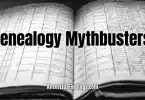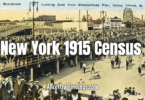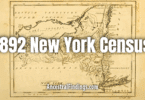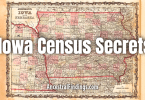The 1870 U.S. Census may be one of the most significant records ever created in the country’s history. For the first time, every person—Black, white, free-born, formerly enslaved, immigrant, farmer, child, war widow—was recorded by name on the main schedule. No longer confined to tally marks or separated into slave schedules, formerly enslaved individuals finally had their names written down as citizens.
This was the country’s first complete census after the Civil War. Reconstruction was underway. Freedmen’s schools and churches were forming. The railroad was pushing west. The country was healing in some ways and breaking in others. But the names were there now. And for family historians, that makes a big difference.
A New Nation, A New Record
The 1870 census continued the format introduced in the 1850 and 1860 censuses. Each person in the household was listed by name, along with their age, sex, color, and birthplace. It also included occupation, real estate value, personal estate value, and whether the person could read or write. If someone had gotten married within the year or attended school, that was also recorded. Disabilities such as blindness, deafness, or mental illness were still noted in a column at the far right.
This census, though, went further in one crucial way: there were no more slave schedules. Slavery was over, and the federal government decided to count all people equally—for the first time—on a single form.
Formerly enslaved individuals were included by name, often for the very first time. They appeared not as property but as heads of households, parents, workers, and children—people building lives in freedom, some just five years into it.
This alone makes the 1870 census one of the most emotionally powerful and significant documents in American history.
A Nation in the Middle of Reconstruction
The 1870 census doesn’t just show individual names—it reveals a country still recovering from the war. In the South, landownership had shifted. Some former enslavers still held large properties, but others had lost everything. In many counties, you’ll see Black farmers and laborers living alongside the families who once enslaved them.
Some African Americans appear as landowners. Others were working as sharecroppers or hired laborers. Some households had elderly parents or grandparents who had lived through slavery and were now experiencing freedom in old age.
Literacy varied widely. In some places, Black adults were beginning to learn to read—while their children were already listed as attending school. That single checkmark next to a child’s name, indicating they had participated in class that year, tells a powerful story of what freedom meant to families as they tried to rebuild.
The occupation column also tells you something more profound. Blacksmiths, farmers, washerwomen, teachers, clergymen—all appear in this census. And not just in the North. In Mississippi, Louisiana, and South Carolina, you’ll find Black men working as carpenters or merchants. You’ll see widowed mothers holding their households together. You’ll find families that had nothing just a few years earlier, now showing a small amount of property and a long list of children.
Research Tips for the 1870 Census
This is one of the best places to start building a complete family profile, especially for African American families. Look at the surname and compare it to those living nearby—sometimes a newly freed person took the name of a former enslaver, but not always. Other times, people chose entirely new names to mark a new beginning. If you’re unsure where the name came from, compare it to nearby white households in the 1860 slave schedule. That can help you find possible connections or at least narrow down the possibilities.
Pay attention to birthplaces, especially for older adults. If a man was born in Virginia, a woman in North Carolina, and their children in Georgia, you can often trace the family’s movement—or forced relocation—over time. That can lead to land deeds, tax records, or plantation papers that help fill in the picture.
If you see someone marked as “cannot read or write,” don’t let that discourage you. The next generation may have attended school, and those records—especially from Freedmen’s schools—might still survive. And for anyone listed as recently married, you may be able to find a local marriage license, church record, or Freedmen’s Bureau marriage register if it happened before 1867.
Don’t overlook occupation patterns, especially among women. Many are listed as domestic servants, but others are listed as seamstresses, nurses, or teachers. These titles can point you to church records, Freedmen’s contracts, or even early business listings in local papers.
Related Records That Make the Census Even More Powerful
The 1870 census is incredibly rich on its own, but it becomes even more powerful when combined with other documents from the Reconstruction period.
Freedmen’s Bureau records often include marriage registrations, school attendance, labor contracts, hospital visits, and relief distributions. These can confirm family relationships, ages, and the exact location of a family in the years leading up to 1870.
Southern Claims Commission files are another incredible source. These were created when individuals who remained loyal to the Union filed for compensation for property taken or destroyed by Union troops. Many of these files include full testimonies, family names, neighbors, and detailed descriptions of the community during the war.
Civil War pension records, especially for Black Union veterans or their widows, can offer birth dates, marriage dates, military service details, and lists of children. If someone was of the right age in 1870—say in their 30s or 40s—it’s worth checking for a pension application later on.
Church records from this era are also essential. Many African American churches were founded in the 1860s and became centers of education, community life, and recordkeeping. Baptisms, marriages, and church records sometimes fill in the gaps where civil records are missing.
Finally, don’t forget about state censuses, tax lists, and school rosters from the early 1870s. Some southern states were just rebuilding their local government systems. If a family doesn’t appear in the 1870 census—or if their record is incomplete—these local lists might help you find them.
Naming Patterns After Emancipation
There’s something especially moving about seeing a name written down for the first time in freedom. In many cases, formerly enslaved people chose their surnames after they were emancipated. Some kept the surname of a former enslaver. Others took on new names entirely—names of admired leaders, trades, or something they felt reflected their new identity.
Sometimes within the same family, you’ll see different surnames used in the 1870 and 1880 census. That’s worth noting. It might reflect a formal marriage, a shift in family leadership, or a desire to start fresh.
We can’t always know the reason—but when someone finally appears in the census by name, it’s a beginning.
Final Thoughts
The 1870 census is more than a government record. It’s a milestone in human dignity. For the first time, every person—regardless of race, birthplace, or legal status—was counted by name on equal footing. It was a symbolic and practical shift. And for many families, it’s the first place their ancestors show up on paper as free individuals.
This census is filled with hope, struggle, resilience, and transition. It holds families still grieving from war, communities rebuilding schools and churches, and people daring to believe that life could be different than what they were born into.
If you’re tracing your family’s story, this census is a gift. Take your time with it. Study each name. Consider the neighbors. Look at occupations, literacy, land value, and age. You might find someone who lived through a lifetime of change—and you may be the first person in generations to call them by name.






